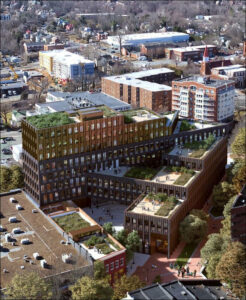
The People’s Republic of Charlottesville is undertaking an interesting experiment — the city has approved development of the Center of Developing Entrepreneurs (CODE), a Silicon Valley-inspired office space, that provides only 74 parking spaces downtown for as many as 600 workers. Worried that the project will aggravate the parking shortage around the Downtown Mall, some local businesses have expressed their unhappiness.
The Center should provide useful insight into the evolving economics of parking. Local governments typically require developers to provide a minimum number of parking spaces per resident or worker. Other downtown businesses have had to abide by the rules, but suddenly CSH Development, developer of CODE is exempt, sparing it considerable development expense. Nearby businesses fear that workers at CODE will swamp the limited supply of public parking.
“I don’t blame [developer Jaffray] Woodriff,” said Jacie Dunkle, owner of the Tin Whistle Irish Pub and the Salad Maker, according to C-ville.com. “I blame the city. It never required him to have more spaces, even though people are struggling to find parking in the city as it is.”
But some economists have argued that most Virginia localities have excess parking, which takes up space that could be devoted to other urban uses. Free marketeers suggest that the market, not government decrees, should determine the supply of parking spaces, and environmentalists advocate limiting parking as a way to curtail automobile use, reduce CO2 emissions and save the planet.
The 167,000-square-foot CODE building, which is being erected on the eastern end of the Charlottevsille’s downtown pedestrian mall, envisions leasing to a diverse tenant mix, providing “innovative companies with a new kind of work environment.” The project aims to become “the nexus of entrepreneurial activity in central Virginia.” The building is designed to achieve LEED Gold certification. Rooftop terraces will provide “expansive green space for tenant use.”
The project conforms to Smart Growth principles by providing ground-level retail, a pedestrian walkway connecting to the downtown pedestrian mall, electric vehicle charging stations, and underground parking that will be convertible to office space “in anticipation of evolving transportation trends.” Other than bicycle racks and showers to accommodate workers who jog or bicycle to work, neither news sources nor the CODE website make note of any measures being taken to reduce automobile usage by tenants or otherwise dampen the demand for parking.
Woodriff, a University of Virginia alumnus, has become wealthy by developing a unique approach to computerized trading. His firm, Quantitative Investment Management, has $4 billion under management, according to his website/blog, Transparent Simplicity. (Financial policy geeks might find his website to be quite interesting. In his latest post, he argues how banks and their lobbyists have created “regulatory sclerosis” by introducing regulatory complexity and uncertainty by means of the Dodd-Frank banking reform act. There is significantly more risk in the U.S. banking system than commonly recognized, he says.)
Bacon’s bottom line: Woodriff may have more in mind than has leaked into the media. Perhaps he is anticipating the advent of Transportation as a Service, in which people subscribe to transportation services as an alternative to owning cars outright. In this vision, people would routinely use Uber-like apps and ride in driverless cars to their destinations, thus eliminating the need for parking spaces. It’s not clear when such services will become widely available, however, and when they do, they will likely appear in major metropolitan areas before reaching small metros like Charlottesville.
The City of Charlottesville is taking a risk by letting Woodriff skate without making the usual commitment to parking. If things work out badly, the city could choke retail commerce and tax revenue. Woodriff is taking some risk, too. He is banking on the idea that roughly 80% of his tenants will either walk, bike, Uber, or take the bus to work — an unprecedented percentage — or find parking spaces elsewhere downtown. Here’s the trick: He’s sharing that risk with the proprietors of other enterprises, who could lose business if the municipal parking system gets overloaded.
This will be fascinating to watch.

Leave a Reply
You must be logged in to post a comment.